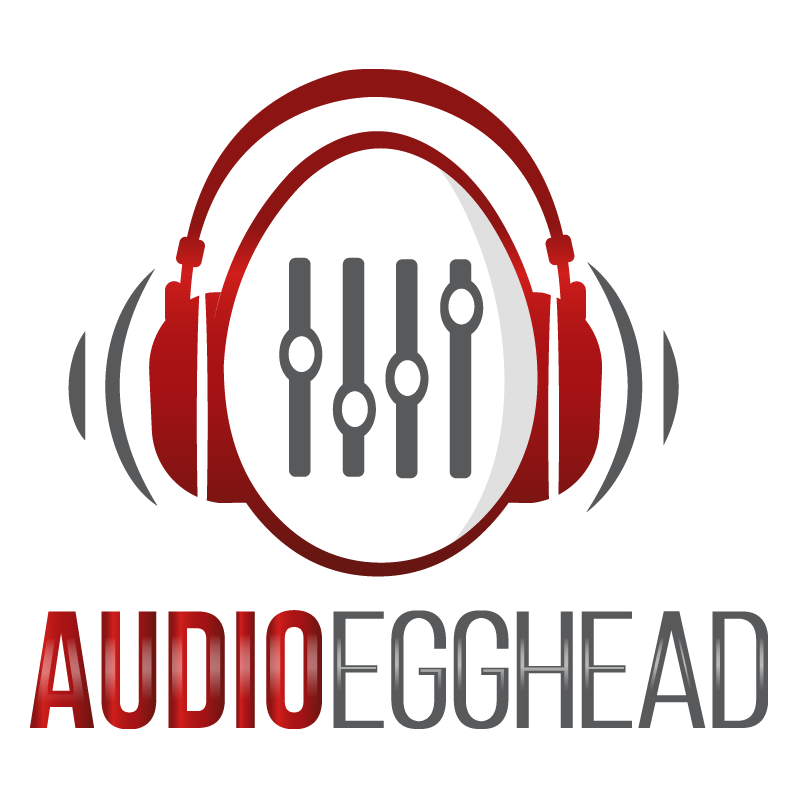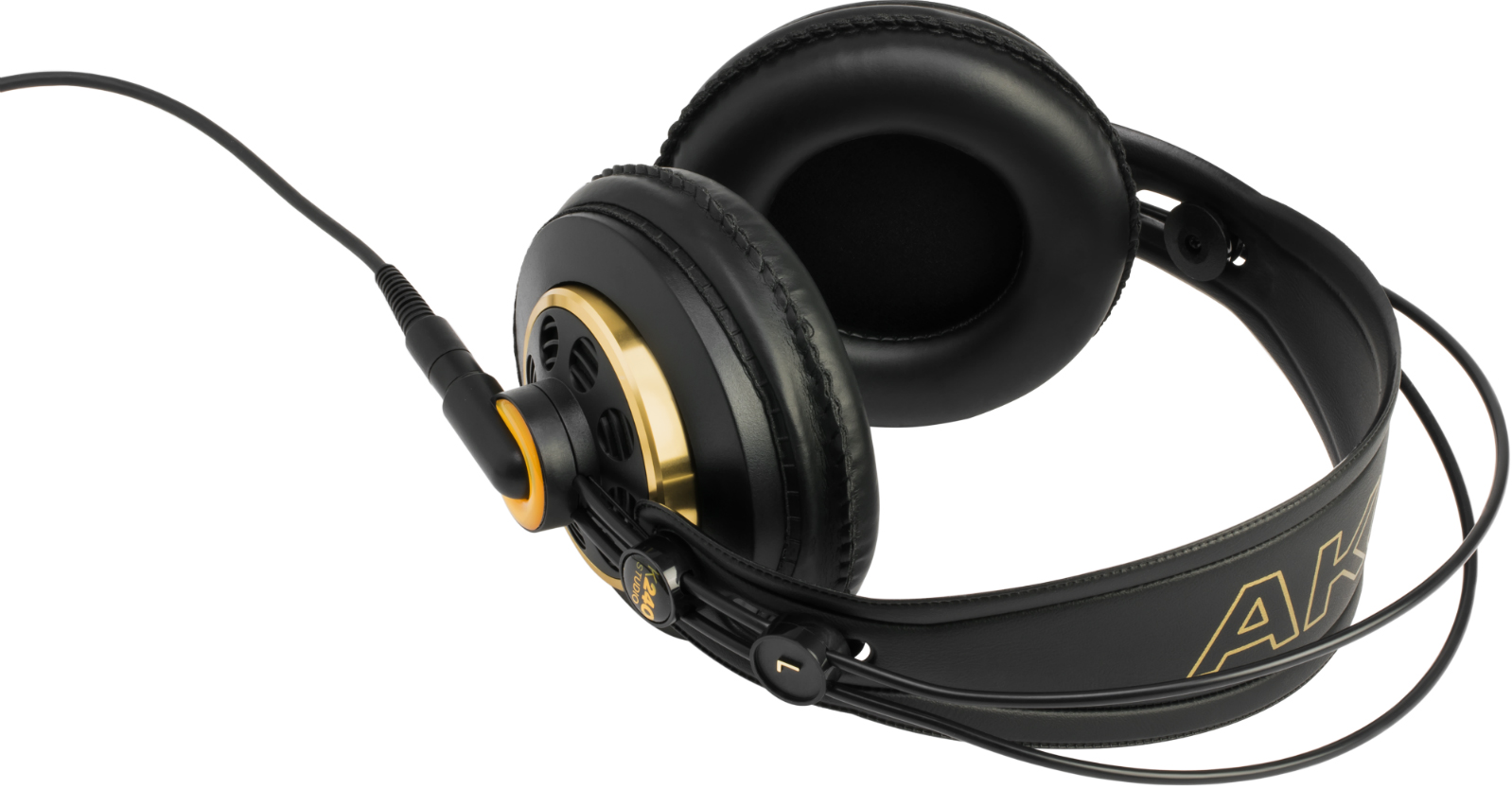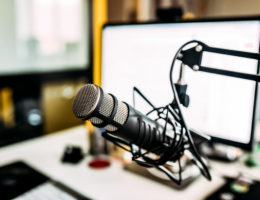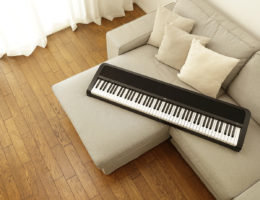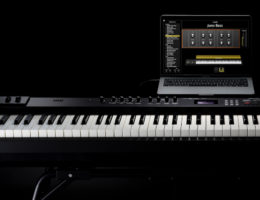There was a time when headphones were just an accessory it was nice to have. But if you’re an audiophile, musician, producer—or really anything to do with music—they’re a necessity. While there are plenty of options, from Sennheiser to Audio Technica, whether you’re mixing or tracking, you have to have a quality set of studio headphones. The AKG K240 headphones are some of the best you can get for under $100.
There aren’t a lot of products these days, especially in the realm of electronics, that can claim to have been in production for nearly 50 years on the same design, but that’s just how good the AKG K240 headphones are. They’re a budget studio standard and have been for a long time. Are they the best? Let’s take a look.
What Are the AKG K240 Studio Headphones?
The AKG K240 are high-quality over-the-ear, semi-open, dynamic studio headphones. What does that mean?
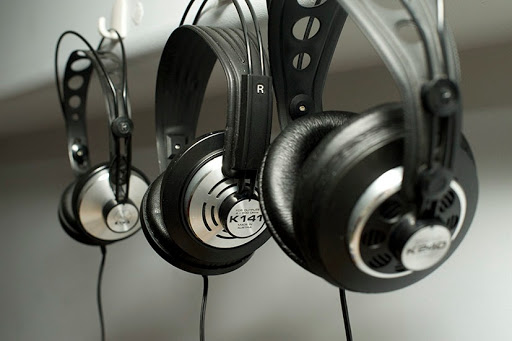
In the Studio
The most important thing to bear in mind is that these AKG headphones are made to perform in your studio. They’re not for losing yourself in the music at Starbucks or locking out the world while you game, like noise-canceling headphones would be. Because of their semi-open design, they let in a lot of ambient noise and they leak a lot of their own, but they have excellent frequency response. The headphone speakers have a built-in headphone amp and use patented Varimotion 30mm XXL transducer technology. They also have a self-adjusting headband.
What these do for you is provide an immersive reproduction of what you’re hearing in the studio,
and at that task, they absolutely excel. They do pretty well when it comes to bass, and they really shine in the mid-range and treble or high end tracks.
No Nonsense in the AKG K240 MKii Headphones
Again: bear in mind the purpose of these headphones. They’re not here to look cool. They aren’t made for gamers. They’re made to function well in the studio across a range of musical genres, from pop to orchestral. They particularly shine in classic rock, acoustic, classical, and detail listening, and offer more of an airy soundstage than noise-canceling headphones would.
They don’t offer the kind of deep, thudding bass that some headphones do, and that’s again on purpose. Deep, thudding bass is mostly for enjoying your favorite tunes. The AKG K240 is all about hearing the entire range and being able to mix it properly.
Product Specs and Frequency Range
The semi-open back build on these headphones makes them light and comfortable, which is perfect for long sessions. They’re also easy to take on and off and look solid. They come with a 10-foot mini XLR to 3.5mm detachable cable with an adaptor for 6.3mm. They don’t perform quite as well for bass as they do mid-levels and treble, but here are the specs you need to know:
Bass Over/Under Emphasis
- Low-bass: -7.22 dB
- Mid-bass: 0.57 dB
- High-bass: 4.56 dB
Mid-Range Over/Under Emphasis
- Low-mid: 4.63 dB
- Mid-mid: 2.36 dB
- High-mid: 0.09 dB
Treble Over/Under Emphasis
- Low-treble: 0.48 dB
- Mid-treble: 1.43 dB
- High-treble: -2.9 dB
Isolation and Sound Quality
If you’re looking for headphones with good isolation, these aren’t it. People around you will be able to hear your music and you’ll be able to hear them. But they aren’t meant to isolate sound, but compared to full open-back headphones these have a lot more isolation.
They provide a good natural, honest sound and that’s exactly what you need in the studio. You want to hear the reality of what’s going on, and the AKG K240 are among the best studio headphones you’ll be able to get in a budget price range.
Pricing
We’ve taken a look at a couple of different studio headphones within a similar price range, and all the ones we’re considering are from big names in the studio headphone game. Several of these, like the AKG K240 and the Philips SHP9500 are fairly old designs but are absolute industry standards.
Everything reviewed here is a pretty affordable price. The cheapest we look at run about $40, while the most expensive are just over $100. With the right sale you could get any of these for under $100 and some for less than $50. The higher pricepoint headsets provide better isolation and a bit stronger build quality: but honestly, a lot of the choice is going to come down to your personal preference and what you’re doing in the home studio, whether its mixing and mastering, making rap beats, rapping, or producing edm. The goal of this article is to help you find the best headphones for your specific type of studio use.
How They Compare Against Other Headphones
The AKG K240 is a great pair of semi-open headphones, but there are other solid choices for professional studio headphones too. In addition to the AKG K240, we’ve also taken a look at these:
But First… A Little More About the AKG K240 MKii Headphones
Price $$
Sound (4 Stars)
What kind of sound are you going to get with these? The perfect sound for mixing. What you hear is accurate and honest. If you’re looking for true-to-life sound, the AKG K240 give you the kind of quality you’d expect from more expensive headphones. They also excel when it comes to stereo effects and make it easy for you to pan mix elements.
The only place they fall down is in the bass levels, and this will only be a problem for you if you mix Hip Hop or a similar genre with a lot of information in the sub-bass level.
Comfort (5 Stars)
Comfort is part of the reason for the AKG K240’s legacy. These headphones don’t look like they would be comfortable. When you look at the AKG K240, you notice there’s no padding on the head strap and that the ear pads don’t seem very padded, either. You expect discomfort but get a pleasant surprise once you put them on.
How can that be? The AKG K240 are very lightweight and do a marvelous job of conforming to your head. You’ll wear them for hours and be fine.
Design Quality (3 Stars)
Are the AKG K240 a cheap build? No… but only just. They almost feel cheap, but they do just manage to avoid being genuinely cheap. They will last longer than you might think when you first look at them. However, there’s one design flaw we wish they’d address. The plastic cups that encase the headband adjustment mechanism will, for some users, end up sitting right behind the ear cups. If that happens with your head, you’ll find them scraping.
Warranty (5 Stars)
The AKG K240 have a solid warranty that lasts for two years from the original date of purchase. Just be aware that you’ll need to submit the warranty card or an original sales receipt in order to get the warranty honored.
Philips SHP9500

The Philips SHP9500 is another industry-standard headphone that you’ll find in a lot of studios. They are over ear headphones, that are open back and offer great, authentic sound. They come with a 1.5m cable. As with the AKG K240, remember that these are not made to give you isolation. These are for the studio, not the living room.
They have a breathable ear cushion, 50mm neodymium drivers, and a durable steel headband. They also look good without being really flashy but be aware that these are quite large headphones.
Price $$$
Sound [4 Stars]
Once again there is a reason you’ll find these headphones in a lot of studios. They have a bright sound with good mid-bass and treble levels and nothing about them sounds hollow. The mid-range isn’t quite as solid as with the AKG K240 and sounds a bit back. These are great for anything that doesn’t need a lot of sub-bass.
Comfort [5 Stars]
These are very comfortable: exceptionally comfortable for the price, really. The headband is soft and hugs your head without being uncomfortable. The ear pads aren’t too hot, and you’ll be able to wear these just as long as any of the most expensive ones on the market.
Design Quality [4 Stars]
Some things about these headphones are great. The steel arm is solid and the plastic parts are decent, considering the price. Some people won’t love the look, though, with the giant L and R marking the cups and the way they sit off the head.
Warranty [4 Stars]
Considering the cost of these headphones compared to the AKG K240, the one-year warranty is a bit of a letdown. However you don’t have to register to get service, and even if you buy the product abroad, Philips will make an honest attempt to honor warranties.
Sony MDR7506

Sony is another big name in the sound world, and these headphones are meant to straddle the line between professional and personal use. Like the Philips and the AKG K240, these headphones still use the same basic design they had when they first came out: and that tells you something about their quality.
There have been some cosmetic upgrades from the original design, but they are still a quality item with 40mm drivers, swiveling ear-cups, and excellent isolation.
Price $
Sound [5 Stars]
Of the headphones we reviewed, these arguably have the best sound. They have good mid-range and treble sound like the others on our list, but they also offer solid and punchy bass; though some people complain that they’re a little on the heavy side. Imaging is good as well. For the studio, these may not provide quite as “true” a sound as you might get with the others; however, they are the only ones that can also transfer over to easy personal listening.
Comfort [5 Stars]
This is a very comfortable thing to wear. The oval ear pads are a hybrid that rests on your ear in the center for a good sound seal, and around your ear at the sides for more comfort.
Design Quality [4 Stars]
In some ways, the design quality is great. These earphones are solid and use metal for nearly everything. On the other hand, they aren’t the prettiest looking things you’ll ever see. They do look old school, which some people might like, but you won’t get away with wearing them outside.
Warranty [2 Stars]
We are definitely not impressed by the limited 90-day warranty on labor and one-year warranty on parts. It’s ok, but given the price and the name, we would expect more.
AKG K72

This is AKG’s seriously budget offering, and if you need something that will work but also need the lowest possible price, you should consider these headphones. They offer a balanced response, come with professional 40mm drivers, and have a closed-back design. They are adjustable, and for the price are very comfortable and durable.
Price $
Sound [4 Stars]
Amazingly, these have great sound. Given the price, you wouldn’t expect much in this department, but all the ranges are solid. They are very airy for closed-back headphones and you can get most details without issue. These headphones fall down just a bit when it comes to dynamics, but the bass response is decent, the mid-levels are snappy, and the treble is clear.
Comfort (4 Stars]
These are pretty comfortable to wear and don’t weigh much. In fact, some users are very fond of how well they fit particularly large heads. They aren’t as adjustable as other offerings. Instead of adjusting, they simply flex. Over time and with use, they can get pushed out.
Design Quality [3 Stars]
When these work, they work amazingly well for the price. The problem is that their design simply isn’t as durable. They can be prone to shorts in the right earpiece, and with regular use, the ear cups may come off.
Warranty [5 Stars]
Again, with AKG you get a solid two-year warranty, and that’s especially good with this pair of headphones. The only downside is remembering to register you product or keep the original receipt in order to get help.
Conclusion
We liked all these headphones and would recommend any of them under the right circumstances. In some ways, you’ll need to choose based on your particular needs, but to point you in the right direction, here are our picks:
Best Overall
We think the AKG K240 are the best combination of durability, comfort, sound quality, warranty coverage, and looks. We loved the true sound, the comfort, and how easy they make it to mix.
Best for Bass
 If you’re mixing or recording with a lot of sub-bass, then we have to recommend the Sony MDR7506 Headphones. These are the best headphones if bass is a big concern. You’ll also going to benefit from their affordable price.
If you’re mixing or recording with a lot of sub-bass, then we have to recommend the Sony MDR7506 Headphones. These are the best headphones if bass is a big concern. You’ll also going to benefit from their affordable price.
Best for a Budget
 You can’t go wrong with the AKG K72 headphones if you’re on a strict budget. These come at a very budget price, but they offer sound as good as almost any on our list. There’s a bit more risk of a short or other failure, but with the two-year warranty you’re probably covered.
You can’t go wrong with the AKG K72 headphones if you’re on a strict budget. These come at a very budget price, but they offer sound as good as almost any on our list. There’s a bit more risk of a short or other failure, but with the two-year warranty you’re probably covered.
What are you waiting for? Grab some quality headphones and get to mixing!
